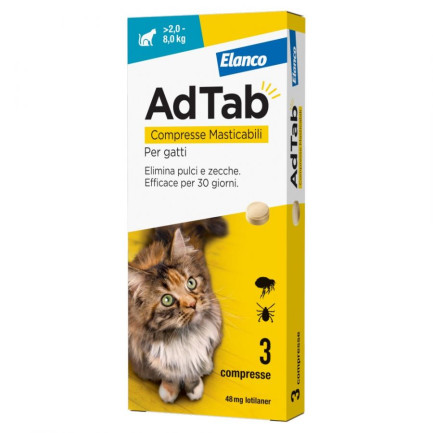FAQ -
AdTab Chewable Tablets for Cats
Can AdTab have side effects?
AdTab is a veterinary medication and, as with all medications, adverse events are possible. Please refer to the package insert for complete information about possible adverse events and always consult your Veterinary Practitioner if in doubt.
How is AdTab administered?
The administration of AdTab is quick and easy. It is recommended that AdTab be administered once a month to eliminate fleas and ticks.
Step 1: Choose dosage of AdTab suitable for the size and weight of the cat.
Step 2: Remove the tablet from the package
Step 3: Put the tablet in the food or let the cat take it from your hand.
Step 4: Be sure to administer the tablet with food or within 30 minutes of the meal for maximum effectiveness.
Step 5: Repeat the treatment monthly.
What is the right package of AdTab for the cat?
AdTab should be administered according to the following schedule to ensure a single dose of Lotilaner (the active ingredient in AdTab) from 6 to 24 mg/kg body weight.
In cats over 8 kg body weight, use an appropriate combination of the available dosages to achieve the recommended dose of 6 to 24 mg/kg.
How many tablets does a package of AdTab contain?
Each package of AdTab for cats contains 3 monthly chewable tablets.
One packet, therefore, provides three months of treatment.
What is the active ingredient in AdTab?
AdTab contains the active ingredient lotilaner. Lotilaner has immediate and persistent knockdown action against fleas and ticks for a full month.
How can the home be treated against fleas?
If the cat has fleas, the house can quickly become infested, as fleas lay eggs on the pet, which fall into the house and hatch into flea larvae. These larvae develop into pupae and eventually develop into adult fleas, ready to bite the pet. The flea eggs, larvae and pupae hide in bedding, carpets, bedding and upholstery throughout the home.
AdTab acts quickly and eliminates existing fleas and new ones infesting the cat before they can lay eggs. Therefore, the product interrupts the flea life cycle and prevents environmental flea contamination in areas to which the cat has access.
If, despite the use of AdTab, you continue to see fleas on your pet, it is likely that they are newly hatched fleas emerging from the house. It is therefore important to proceed with regular monthly treatments so that new fleas, as they jump onto the pet, are killed.
In the case of a massive flea infestation, and at the beginning of control measures, these pet resting areas should be treated with a suitable environmental product and then cleaned regularly.
If after using the pesticide, ticks are still present on the cat, what should I do?
If ticks are still visible on the pet, there can be several reasons. Ticks can get on the cat's fur when it passes by it, even if the pet has been treated. Ticks must start feeding on the host to be exposed to lotilaner, so they can attach. It is possible to see ticks still attached but dead; this happens especially in areas of high parasite pressure.




